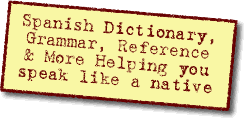Ask a Question(Create a thread) |
|
|||||||
Why le is used?Grammar questions– conjugations, verb tenses, adverbs, adjectives, word order, syntax, etc. |
|
|
Thread Tools |
|
Get rid of these ads by registering for a free Tomísimo account.
|
|
#3
|
||||
|
||||
|
Both are valid phrases, but mean different things. 'Le' is an indirect object pronoun and is used when there is an indirect object.
Looking at just your first phrase, the arrangement 'Le dice Juan' or 'Juan le dice' would mean the same thing - 'John tells him/her/you/it'. 'Juan' is the subject. In Spanish, the subject can be said on either side of the verb and the meaning of the sentence remains the same. If we wanted to say that 'Juan' is the person who is being told something, then 'Juan' would become the indirect object and would need to be introduced with the preposition 'a', e.g., 'Le dice a Juan' or 'A Juan le dice'. Note that the indirect object 'a Juan' can appear on either side of the verb in Spanish. Looking at these new phrases, the indirect object pronoun 'le' is NOT needed in the first arrangement (but it may be said, and it often is). When the indirect object precedes the verb, as it does in the second arrangement, the indirect object pronoun 'le' MUST be used. Your second phrase, 'Dice Juan' means the same thing as 'Juan dice' - 'John says'. The subject 'Juan' can appear on either side of the verb in Spanish. The difference, then, between your two phrases, is that one has an indirect object and the other does not. Neither phrase needs to remain a phrase. Make them a complete sentence by providing either the thing that was told/said or substitute the direct object pronoun 'lo', if the topic has already been stated. 'Se lo dice Juan'/'Juan se lo dice' or 'Lo dice Juan'/'Juan lo dice' would be a complete sentence, e.g., 'John tells/says it to him/her/you/it' or 'John says it' ('it' referring to the established topic of discussion). The Spanish don't like the sound of 'le lo', so that is why the indirect object pronoun 'le' in the first sentence is changed to 'se' when the direct object pronoun is added to the make the sentence complete. Update: Cross-posted with AngelicaDeAlquezar |
| Link to this thread | |
| Thread Tools | |
|
|
|
|
|||||||
All times are GMT -6. The time now is 04:58 PM.






